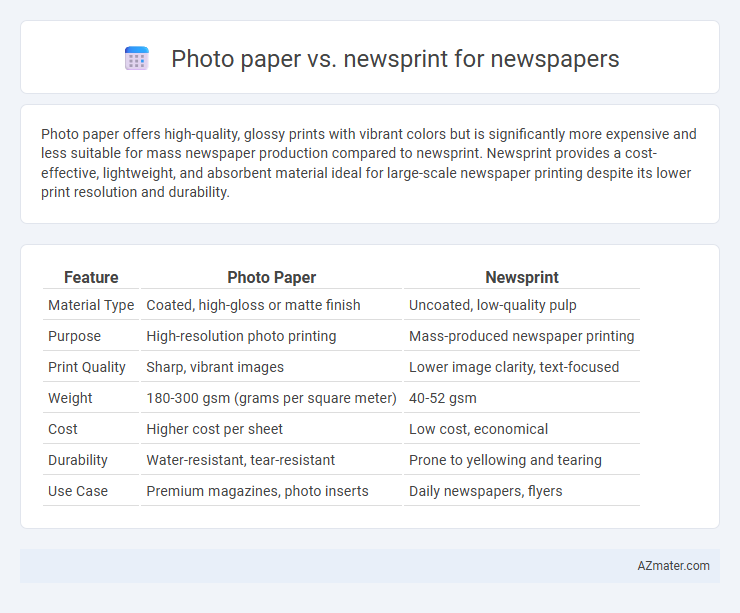Photo paper offers high-quality, glossy prints with vibrant colors but is significantly more expensive and less suitable for mass newspaper production compared to newsprint. Newsprint provides a cost-effective, lightweight, and absorbent material ideal for large-scale newspaper printing despite its lower print resolution and durability.
Table of Comparison
| Feature | Photo Paper | Newsprint |
|---|---|---|
| Material Type | Coated, high-gloss or matte finish | Uncoated, low-quality pulp |
| Purpose | High-resolution photo printing | Mass-produced newspaper printing |
| Print Quality | Sharp, vibrant images | Lower image clarity, text-focused |
| Weight | 180-300 gsm (grams per square meter) | 40-52 gsm |
| Cost | Higher cost per sheet | Low cost, economical |
| Durability | Water-resistant, tear-resistant | Prone to yellowing and tearing |
| Use Case | Premium magazines, photo inserts | Daily newspapers, flyers |
Understanding Photo Paper and Newsprint
Photo paper features a glossy, coated surface designed to produce sharp, vibrant images with high color accuracy, making it ideal for photographic reproductions in newspapers. Newsprint, by contrast, is a lightweight, uncoated paper made from wood pulp, optimized for fast printing and high circulation with lower production costs but lower image quality and durability. Understanding these differences helps publishers select appropriate materials based on budget constraints, print quality expectations, and intended use of the newspaper content.
Key Differences in Paper Composition
Photo paper features a coated surface with a high concentration of clay or polymer to enhance image sharpness and color vibrancy, making it ideal for high-quality photo reproduction. Newsprint, composed primarily of groundwood pulp with minimal bleaching and coating, is designed for cost-effective mass printing with lower brightness and durability. The key difference lies in the fiber content and finishing process, where photo paper emphasizes smoothness and opacity, while newsprint prioritizes absorbency and economical production.
Print Quality Comparison
Photo paper offers significantly higher print quality for newspapers, delivering sharp images, vibrant colors, and enhanced contrast due to its glossy, coated surface that absorbs ink precisely. Newsprint, designed primarily for cost efficiency, results in lower resolution prints with muted colors and less detail, often producing grainy or fuzzy images prone to ink bleed. For newspapers prioritizing visual clarity and color accuracy, photo paper outperforms newsprint by providing superior image fidelity and crisp text reproduction.
Color Reproduction Capabilities
Photo paper offers superior color reproduction capabilities compared to newsprint, delivering vibrant, sharp, and high-resolution images ideal for high-quality newspaper inserts or special editions. Newsprint, made from lower-grade pulp, absorbs ink more readily, resulting in duller colors and lower image clarity, which is sufficient for standard text and monochrome prints. The coated surface of photo paper resists ink absorption, enhancing color accuracy and saturation, making it the preferred choice for newspapers aiming to showcase rich full-color photographs.
Durability and Longevity
Photo paper exhibits superior durability and longevity compared to newsprint due to its glossy coating and higher-quality fibers, which resist fading, yellowing, and tearing over extended periods. Newsprint, commonly made from low-cost, recycled wood pulp, tends to degrade quickly when exposed to light, moisture, and handling, leading to brittleness and discoloration within months. In archival settings, photo paper is preferred for preserving image quality and detail, whereas newsprint is typically suited for short-term use and rapid recycling.
Environmental Impact Analysis
Photo paper typically has a higher environmental impact than newsprint due to its production process involving plastic coatings and chemical treatments that hinder recyclability. Newsprint, made from recycled fiber and uncoated pulp, is more biodegradable and easier to recycle, reducing landfill waste and energy consumption. Choosing newsprint over photo paper significantly lowers carbon emissions and resource depletion in newspaper printing.
Cost Considerations
Photo paper costs significantly more than newsprint due to its higher-quality materials, coating, and glossy finish, making it less economical for mass newspaper printing. Newsprint offers a low-cost alternative with its inexpensive, uncoated, and lightweight properties, enabling large-scale production and distribution at minimal expense. Choosing newsprint maximizes cost efficiency for daily newspapers, while photo paper is reserved for special editions or inserts demanding superior image quality despite higher printing costs.
Suitability for Different Newspaper Types
Photo paper offers high gloss and sharp image quality, making it suitable for premium newspapers and magazines focused on vibrant color photos and detailed graphics. Newsprint, made from inexpensive, lightweight pulp, is ideal for daily newspapers and mass circulation publications where cost-efficiency and fast production are essential. Different newspaper types choose photo paper for luxury editions, while newsprint remains the standard for general news due to its affordability and adequate print clarity.
Reader Experience and Perception
Photo paper enhances newspaper reader experience with sharper images, richer colors, and smoother texture, making visuals more engaging and easier to interpret. Newsprint offers a traditional tactile feel but tends to produce duller images and can cause eye strain due to lower brightness and rough surface. Readers perceive newspapers printed on photo paper as higher quality and more premium, while newsprint conveys affordability and authentic newspaper appeal.
Choosing the Right Paper for Your Publication
Selecting the right paper for your newspaper hinges on balancing budget, print quality, and durability. Photo paper offers vibrant colors and sharp images, ideal for high-end magazines or special inserts, but its higher cost and glossy finish may reduce readability and increase production expenses. Newsprint remains the industry standard for newspapers due to its affordability, lightweight nature, and suitability for mass distribution, despite lower image resolution and quicker wear over time.

Infographic: Photo paper vs Newsprint for Newspaper
 azmater.com
azmater.com